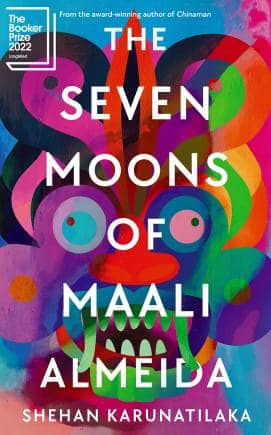With 'The Seven Moons of Maali Almeida', Shehan Karunatilaka has absorbed influences and created a novel that shows their traces but does not mimic them. (Images via Amazon.in)
There are several names listed in the Acknowledgements section of Shehan Karunatilaka’s Booker Prize-winning The Seven Moons Of Maali Almeida. Among them are George Saunders, Kurt Vonnegut, Douglas Adams, and Cormac McCarthy. The influence of these writers is evident in the pages of Karunatilaka’s novel.
Consider George Saunders’s dazzling Lincoln in the Bardo, to begin with. It is set in a purgatory-like realm in which the souls of the deceased ponder on  their lives and try to complete unfinished business before journeying on to their final state. Based on an actual incident, the untimely death of Abraham Lincoln’s young son, it’s a long, strange trip of the ultimately grateful dead which itself won the Booker in 2017.
their lives and try to complete unfinished business before journeying on to their final state. Based on an actual incident, the untimely death of Abraham Lincoln’s young son, it’s a long, strange trip of the ultimately grateful dead which itself won the Booker in 2017.
This premise has similarities with The Seven Moons Of Maali Almeida, which is narrated in second person by the murdered photographer of the title. At the start, a befuddled Almeida finds himself in a bureaucratic afterlife, an in-between zone populated by other spirits, some friendly and others threatening. He is told that he has seven moons, meaning days and nights, in which to discover how and by whom he was killed. The task involves travelling to the real world on winds and whispers and uncovering a cache of incriminating photographs.
The novel is set in the fevered and paranoid environment of 1980s Sri Lanka. Then and now, in that country and elsewhere: “Evil is not what we should fear. Creatures with power acting in their own interest: that is what should make us shudder.”
From Kurt Vonnegut, Karunatilaka takes black humour as a way to satirise human conduct, as well as an irreverence rooted in humanism. In Slaughterhouse Five, based on Vonnegut’s experiences during the 1945 aerial bombing of Dresden, he writes: “I think you guys are going to have to come up with a lot of wonderful new lies, or people just aren't going to want to go on living.”
In a complementary sentence from The Seven Moons of Maali Almeida, we read: “It is not Good vs Evil out here. It is varying degrees of bad, squabbling with conglomerates of the wicked.” Later, in a comment that sums up the situation at the time: “The government forces, the eastern separatists, the southern anarchists and the northern peacekeepers are all prolific producers of corpses.”
Karunatilaka’s novel also contains a great deal of the anarchic sensibility of Douglas Adams’s The Hitchhiker’s Guide to the Galaxy series. In Life, the Universe and Everything, Arthur Dent hopes and prays that there isn’t an afterlife. “Then he realised there was a contradiction involved here and merely hoped that there wasn't an afterlife.” Meanwhile, Maali Almeida discovers that “the afterlife is a tax office and everyone wants their rebate”.
Not only that: “The Afterlife is as confusing as the Before Death, the In Between is as arbitrary as the Down There. So we make up stories because we’re afraid of the dark.” In passing, if Adams’s protagonist is advised to always carry a towel on his interstellar journeys, Karunatilaka’s Almeida also finds his red bandana useful on more than one occasion.
Cormac McCarthy may seem like the odd person out on this list, but in many of his novels, and in Karunatilaka’s book, there is an arresting end-of-the-world bleakness. At one point, Almeida thinks: “When the wind blew through the balcony and the smoke and the laughter filled the breeze, it was easy to forget that a horrible war was being fought a bus ride from here. Over here the stars and the lights of Colombo sang out in yellows and greens.”
On the other hand, as with The Road’s depiction of an apocalyptic wasteland, Karunatilaka does not shy away from depicting the horrors of Sri Lanka’s civil war. Indeed, some passages on violence and its aftermath are rather unsettling.
All of this may sound as though Karunatilaka has done little more than take bits and pieces from writers he admires and stitched them together to create an unoriginal skein. That is far from the case. As with many notable writers, he has absorbed influences and created a novel that shows their traces but does not mimic them. The spirit of their work inhabits the book, along with Karunatilaka’s other ghouls, pretas, and demons, to make it a rich and satisfying concoction.